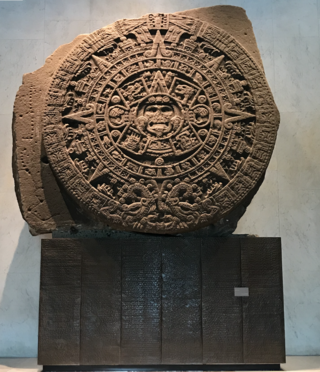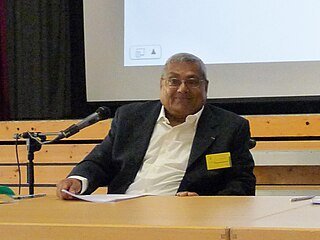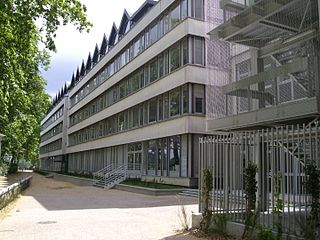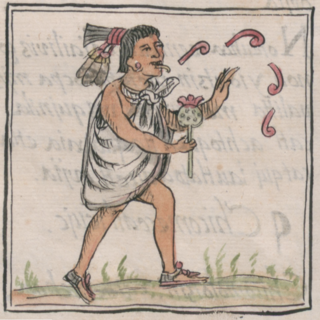
The Aztec or Mexica calendar is the calendrical system used by the Aztecs as well as other Pre-Columbian peoples of central Mexico. It is one of the Mesoamerican calendars, sharing the basic structure of calendars from throughout the region.

Sorbonne University is a public research university located in Paris, France. The institution's legacy reaches back to the Middle Ages in 1257 when Sorbonne College was established by Robert de Sorbon as a constituent college of the University of Paris, one of the first universities in Europe. Its current iteration was formed in 2018 by the merger of Paris-Sorbonne University and the Université Pierre et Marie Curie.

The Nahuas are a Uto-Nahuan ethnicity and one of the indigenous people of Mexico, with Nahua minorities also in El Salvador, Guatemala, Honduras, Nicaragua, and Costa Rica. They comprise the largest indigenous group in Mexico, as well as the largest group of Native Americans in North America by number of native speakers, and the third in the Americas after Guaraní and Quechua.

Miguel León-Portilla was a Mexican anthropologist and historian, specializing in Aztec culture and literature of the pre-Columbian and colonial eras. Many of his works were translated to English and he was a well-recognized scholar internationally. In 2013, the Library of Congress of the United States bestowed on him the Living Legend Award.

Mesoamerican languages are the languages indigenous to the Mesoamerican cultural area, which covers southern Mexico, all of Guatemala, Belize, El Salvador, and parts of Honduras, Nicaragua and Costa Rica. The area is characterized by extensive linguistic diversity containing several hundred different languages and seven major language families. Mesoamerica is also an area of high linguistic diffusion in that long-term interaction among speakers of different languages through several millennia has resulted in the convergence of certain linguistic traits across disparate language families. The Mesoamerican sprachbund is commonly referred to as the Mesoamerican Linguistic Area.

The Nahuan or Aztecan languages are those languages of the Uto-Aztecan language family that have undergone a sound change, known as Whorf's law, that changed an original *t to before *a. Subsequently, some Nahuan languages have changed this to or back to, but it can still be seen that the language went through a stage. The best known Nahuan language is Nahuatl. Nahuatl is spoken by about 1.7 million Nahua peoples.
Classical Nahuatl, also known simply as Aztec or Codical Nahuatl and Colonial Nahuatl, is a set of variants of Nahuatl spoken in the Valley of Mexico and central Mexico as a lingua franca at the time of the 16th-century Spanish conquest of the Aztec Empire. During the subsequent centuries, it was largely displaced by Spanish and evolved into some of the modern Nahuan languages in use. Although classified as an extinct language, Classical Nahuatl has survived through a multitude of written sources transcribed by Nahua peoples and Spaniards in the Latin script.

Prithwindra Mukherjee was a French-Indian writer and researcher. Until his retirement in 2003, he was a researcher in the Human and Social Sciences Department (Ethnomusicology) of the French National Centre of Scientific Research in Paris. Mukherjee was also an author of a number of books and other publications on various subjects.
Baku Slavic University (BSU) is a public university located in Baku, Azerbaijan.
Popoluca is a Nahuatl term for various indigenous peoples of southeastern Veracruz and Oaxaca. Many of them speak languages of the Mixe–Zoque family. Others speak the unrelated Mazatecan languages, in which case the name in English and Spanish is generally spelled Popoloca.

San Andrés Hueyapan is a small town in the rural northeastern part of the Mexican state of Morelos, formerly in the municipality of Tetela del Volcán. It lies at an elevation of ca 2000–2500 metres above sea level on the southern slopes of the active volcano Popocatépetl. To the west of Hueyapan runs the Amatzinac river, to the north is the Popocatépetl-Iztaccíhuatl natural reserve, and to the south the town of Tlacotepec and to the east is the municipality of Tochimilco which belongs to the state of Puebla located in the midlands.

The Sorbonne Nouvelle University is a public liberal arts and humanities university in Paris, France. It is one of the inheritors of the historic University of Paris, which was completely overhauled and restructured in 1970.

The University of Tours, formerly François Rabelais University of Tours, is a public university in Tours, France. Founded in 1969, the university was formerly named after the French writer François Rabelais. It is the largest university in the Centre-Val de Loire region. As of July 2015, it is a member of the regional university association Leonardo da Vinci consolidated University.
Louise M. Burkhart is an American academic ethnohistorian and anthropologist, noted as a scholar of early colonial Mesoamerican literature. In particular, her published research has a focus on aspects of the religious beliefs and practices of Nahuatl-speakers in central Mexico. Her work examines the historical documentation from the time of the Spanish Conquest and the subsequent era of colonial Mexico, and studies the continuities and transformations of indigenous Nahua communities and culture. Burkhart has written extensively on colonial Nahuatl drama, folklore, poetry and catechistic texts, translating a number of these documents from the original Nahuatl with commentaries and historical interpretations and notes. She has also published research on the aesthetics and iconography of pre-Columbian and Indochristian art, Nahuatl linguistics, and the rise of the Virgin of Guadalupe cult within Mexican Roman Catholicism.
Lisa Sousa is an American academic historian active in the field of Latin American studies. A specialist in the colonial-era history of Latin America and of Colonial Mexico in particular, Sousa is noted for her research, commentary, and translations of colonial Mesoamerican literature and Nahuatl-language historical texts. She has also published research on historical and contemporary indigenous peoples in Mexico, the roles of women in indigenous societies and cultural definitions of gender. Sousa is a full professor in the History Department at Occidental College in Los Angeles, California.

Nahuatl, Aztec, or Mexicano is a language or, by some definitions, a group of languages of the Uto-Aztecan language family. Varieties of Nahuatl are spoken by about 1.7 million Nahuas, most of whom live mainly in Central Mexico and have smaller populations in the United States.

The University of French Polynesia is a French university located in Puna'auia, French Polynesia.
Morelos Nahuatl includes varieties of the Nahuatl language that are spoken in the state of Morelos, Mexico. In Morelos, Nahuatl is spoken in the communities of Cuentepec, Hueyapan, Santa Catarina, Xoxocotla, Atlacholoayan and Tetelcingo. But Tetelcingo Nahuatl is usually considered a separate variety due to its highly innovative phonology, and has very low mutual intelligibility with the other Morelos variants. Ethnologue also considers the varieties of San Felipe Tocla and Alpanocan to belong to the Morelos Nahuatl group of dialects although they are located in the state of Puebla. The dialects belong to the Central dialects closely related to Classical Nahuatl.

Modesta Lavana Pérez was an indigenous Nahua healer and activist from the town of Hueyapan, Morelos, Mexico. She was recognized as an important activist for indigenous rights and women's rights in Morelos, where she worked as a healer and as a legal translator of the Nahuatl language for the state of Morelos. She was also an authority on local ethnobotany, and on the usage of the temazcal sweat bath. Her traditional wool weavings on the backstrap loom were well known within the state of Morelos, and received many prizes.

The Nahuatl language in the United States is spoken primarily by Mexican immigrants from indigenous communities and Chicanos who study and speak Nahuatl as L2. Despite the fact that there is no official census of the language in the North American country, it is estimated that there are around 140,800 Nahuatl speakers. During the last decades, the United States has carried out many educational initiatives aimed at teaching Nahuatl as a language of cultural heritage.













